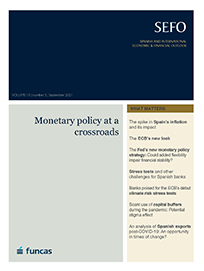Monetary policy at a crossroads
Fecha: september 2021
SEFO, Spanish and International Economic & Financial Outlook, V. 10 N.º 5 (September 2021)
Index
[expand title= "The spike in Spain’s inflation and its impact"]
The upward trend in Spanish inflation has been driven by rising input costs, the abrupt nature of the global recovery and nascent structural transformations accelerated by the pandemic. While the immediate effect is a slowdown in the pace of recovery, further ahead, if global inflation becomes sustained, the perception of central bank independence will be key.
[/expand] [expand title= "The ECB’s new look"]The results of the ECB’s monetary strategy review announced in July suggest Christine Lagarde has succeeded in her promise to transform how the ECB works and how it communicates with the outside world. However, her first real test will come as the Bank begins to unwind its unconventional monetary policy instruments.
[/expand][expand title= "The Fed’s new monetary policy strategy: Could added flexibility impair financial stability?"]
The new monetary policy strategy adopted by the Federal Reserve last year has impacted both inflation expectations and the risk premia. However, analysis suggests it is unlikely to push yields high enough to threaten financial stability.
[/expand][expand title= "Stress tests and other challenges for Spanish banks"]
The stress tests carried out by the European authorities showed that the Spanish banking sector looks highly resilient to adverse scenarios, despite the fact that the scenario modelled for Spain was among the toughest in the eurozone. Nevertheless, transition towards an even more stringent regulatory environment in terms of capital adequacy suggests that Spanish banks will have to continue to bolster their own funds over the coming years.
[/expand][expand title= "Banks poised for the ECB’s debut climate risk stress tests"]
The ECB’s climate stress tests slated for 2022 will differ from traditional stress tests in terms of governance, objective, methodology, scenarios and scope. Nevertheless, the ECB’s deep engagement with this issue suggests a high probability that climate risks will be integrated into conventional stress tests in the future.
[/expand][expand title= "Scant use of capital buffers during the pandemic: Potential stigma effect"]
In order to alleviate the pressure wrought by COVID-19 on the banking sector, regulators and supervisors permitted banks to utilise capital buffers prescribed under Basel III, including the so-called countercyclical buffer and the capital conservation buffer. Econometric analysis shows that the ‘stigma effect’ most likely explains banks’ hesitancy to take advantage of this flexibility.
[/expand][expand title= "An analysis of Spanish exports post-COVID-19: An opportunity in times of change?"]
Following the drop in international trade caused by COVID-19, Spain saw a strong rebound in exports. While it is too soon to say whether this marks a turning point for Spanish exporters, some early data point to a structural shift in Spain’s trading patterns.
[/expand]
